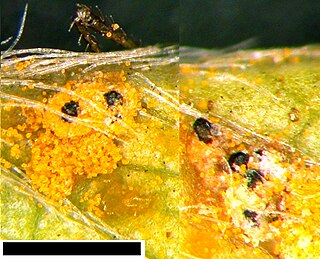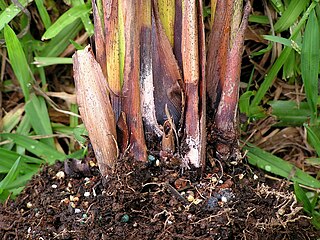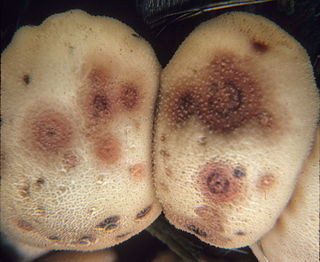| Coniothyrium | |
|---|---|
 | |
| Coniothyrium ilicis | |
| Scientific classification | |
| Kingdom: | |
| Division: | |
| Class: | |
| Order: | |
| Family: | |
| Genus: | Coniothyrium Corda (1840) |
| Type species | |
| Coniothyrium palmarum Corda (1840) | |
| Synonyms [1] | |
Coniothyrium is a genus of fungi in the family Coniothyriaceae. The genus was circumscribed by Czech mycologist August Carl Joseph Corda in 1840. [2] It was formerly placed in the Phaeosphaeriaceae family until 1983 when the family was established.
The genus are diverse geographically, [3] and have a cosmopolitan distribution across the world. [4]
The etymology of Coniothyrium is derived from New Latin, from coni- (from conus) and thyr- (from Greek thyreos meaning oblong shield, from thyra meaning door) and -ium (ending for a genus). [5]
Coniothyrium palmarum is the type species of the genus Coniothyrium. It is characterised by ostiolate pycnidial (asexual fruiting body) conidiomata, annellidic conidiogenous cells, the absence of conidiophores, and brown, thick-walled, 0- or 1-septate, verrucose conidia. Coniothyrium is similar morphologically to some species in the genus Microsphaeropsis . However, Microsphaeropsis is characterised by the production of phialidic conidiogenous cells with periclinal thickening, and thin-walled, pale greenish brown conidia. [3]
Species Coniothyrium glycines (R.B. Stewart) Verkley & Gruyter (2012) is known to cause red leaf blotch on Soyabean. [6] While Coniothyrium fuckelii is also a known plant pathogen (causing stem canker, [7] ) that has also been known to cause infections in immunocompromised humans. [8] Coniothyrium phyllachorae Maubl. (1904) with other fungus species such as Phyllachora maydis Maubl. and Monographella maydis Müller & Samuels are the causes of Latin America tar spot complex in places such as Guatemala, Mexico, Colombia, and El Salvador. [9]
Species Coniothyrium ferrarisianum has been isolated from leaves of Daphne mucronata Royle in Iran, [10] it was originally isolated from Acer pseudoplatanus L. in Italy in 1958, [11] and it was later found on Vitis vinifera L. in Canada in 2017, [12] as well as Prunus spp. in Germany in 2020, [13] and also from Olea europaea L. in South Africa in 2020. [14]






